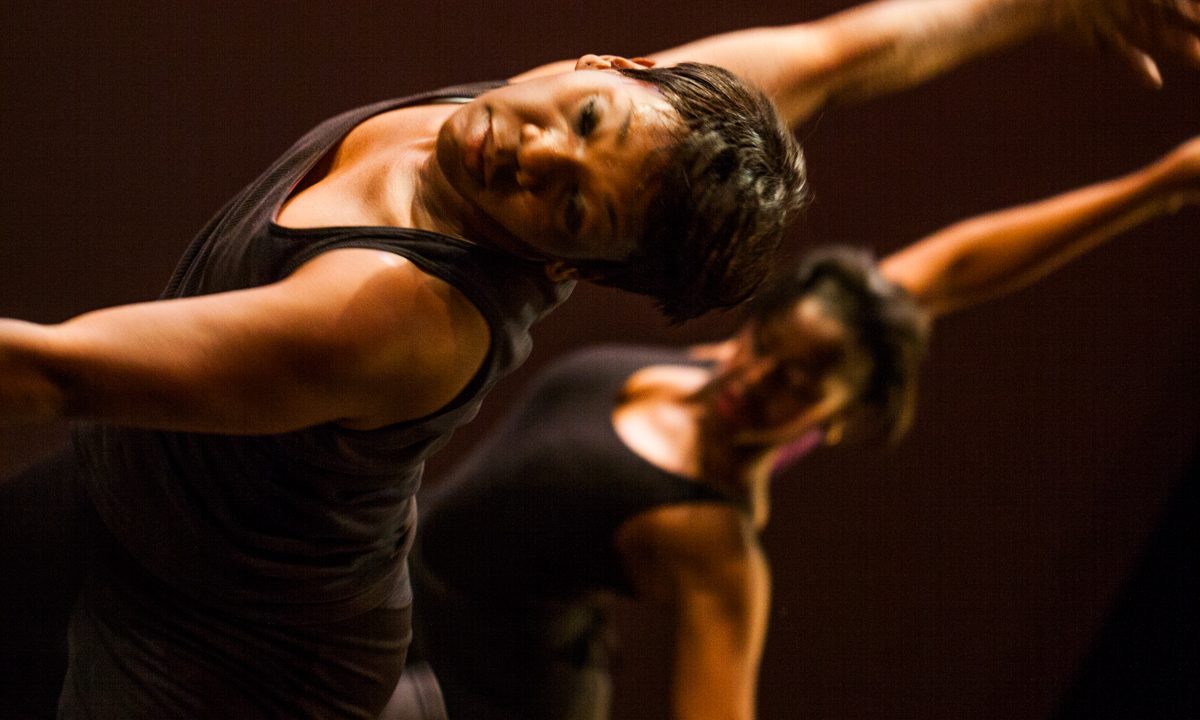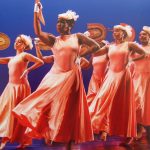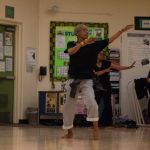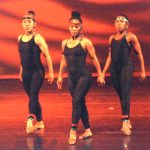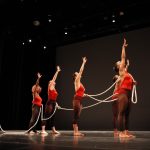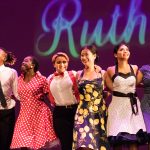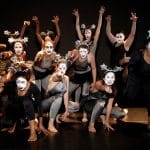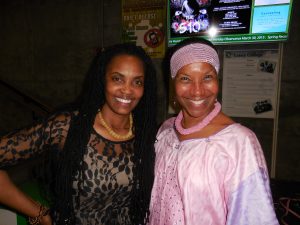ABOUT MODERN DANCE (A very brief & condensed history)
Modern Dance is a term that describes many types of dance techniques. It’s a category of dance styles, often referred to as a genre of dance. Many of the main styles in this genre are credited to specific choreographers who pioneered new and unique ways of moving and created new movement vocabularies based on their personal philosophies; their views of how dance functions as an artistic tool. Dancers trained in private dance studios often tend to associate or refer modern dance with the terms lyrical or contemporary dance. While these studios and competition forms may have some movements in common with professional concert modern dance, lyrical dance actually refers to a quality of movement. Contemporary dance usually means that it has been created recently, is performed to contemporary music, and is a fusion of ballet, jazz and modern styles.
What then makes something Modern Dance? There are no absolute lines drawn in the world of professional dance, but for purposes of this class, here are limited definitions of modern dance forms that have at least one of the following characteristics:
- Based on one of the codified techniques of the early masters, such as Graham, Humphrey, Limón, Dunham, Horton or Cunningham
- Based on movements created by use of breath, articulation of the torso (such as aligned, titled, or contracted), use of the floor, or improvisation, without the need for turned-out positions of the legs or pointed feet
- A fusion of dance styles that use the movement vocabulary of ballet, jazz, modern, hip-hop, Afro-Caribbean, capoeira and post-modern dance in the same choreography
- A strong association with the ground in movement choices; an emphasis on grounded movement when standing and a vocabulary of movements done while lying or seated on the floor.
Rather than a concise definition of what Modern Dance is, perhaps more important to you is what it can contribute to the enrichment of your life. It can introduce you to a new form of technique in which you experience the joy of movement. It can heighten your appreciation of music, other various arts and movement forms. It can increase your respect and understanding of the dancer’s profession. It can also expand your awareness and appreciation of the way you and others move.
Every artist is a product of the time in which he or she creates. While early modern dance artist were frequently on the cutting edge of change, many also reflected the social and political prejudices and circumstances of their time. The driving force for many artist in the beginning of the 20th century was their search for elements of dance.
While it is not possible to give adequate recognition to all of the choreographers, producers, educators and dancers who have shaped modern dance, several prominent individuals can help in tracing the development of the art form as it is practiced in the studio and often performed today.
- 1900 – 1920: The Matriarchs, Loie Fuller, Isadora Duncan and Ruth St.Denis
- 1920 – 1940: The Pioneers, Ted Shawn, Doris Humphrey, Martha Graham, Mary Wigman, Katherine Dunham
- 1940 – 1960: 2nd Generation, the Legacy Builders, José Limón, Hanya Holm
- 1940 – 1960: 2nd Generation, the Iconoclasts, Merce Cunningham, Lester Horton, Alwin Nikolais
- 1960 – 1980: Synthesizers, Alvin Ailey, Paul Taylor, Twyla Tharp
- 1980 – 2000: Collaborators, Pilobolus, Bill T. Jones
In the past, ‘Modern Dance’ represented the viewpoints and movement concepts of each of several dancers or choreographers. .. Martha Graham technique, Doris Humphrey Technique, or Lestor Horton Technique. As the horizons of the dance artist have widened, so have the movement forms, which look more alike, than uniquely different. Modern dance is a younger art form than ballet and the movement style centers on the dancer’s own interpretations instead of the standardized movements and structured steps of classical or traditional ballet. However, Modern dance does use many of the classical vocabulary and terminology. Today many ‘ballet’ choreographers utilize the movement concepts of the modern dancer and exercises of the ballet dancer are now used in the ‘modern’ techniques. Modern dance is known for its independence, invention and non-traditional attitude. Many choreographers now include in their work not only the elusive modern dance techniques, but also the principles of Jazz, African, Ballet, and other ethnic dance.
The development of Modern dance as an art form came about by breaking the ‘rules’ of what dance was ‘supposed’ to be. During the 1900’s European dancers began rebelling against the rigid rules of classical ballet, the structured techniques, costumes and ballet shoes. Toward the end of the 19th century dedicated individuals like Loie Fuller, Ruth St. Denis, Isadora Duncan and Ted Shawn were performing regularly. For want of a better name “classic” dance was affixed to the work of those artists who patterned their works on idealized Greek or Roman models. These new dancers favored a more relaxed, free style of dancing. Modern dance pioneers danced in bare feet and free flowing often revealing costumes.
Modernism versus Realism
Many artist engaged in a deliberate departure from realistic depiction in art to what became known as modernism. This new style explored subjective experience, such as one’s feelings and perceptions rather than observed real life. The work looked abstract as opposed to realistic. For example; the works of painter Pablo Picasso, which contain recognizable body parts but not the realistic face of a woman, are an example of this modernist movement in art. The new dance, or modern dance as it later become known, was interested in depicting the abstraction of the human experience rather than a realistic retelling of a story. The new dance form explored persona feelings about the world through abstracted, uncluttered, and nonliteral movement. Just as modernism in art, modern dance manifested itself as a rebellion against the artistic traditions of the past.
St. Denis and Ted Shawn came together professionally and established a school in the Westlake district of Los Angeles that attracted students from around the country. St. Denis was the muse, role model and sometimes teacher, while Shawn focused primarily on the details school. Their company, named Denishawn toured on the popular vaudeville circuits and was the most important serious dance company in the country.
By the second decade of the 20th century the name “Modern Dance” had begun to be used to describe the work of Denishawn successors such as Martha Graham, Doris Humphrey, Charles Weidman, Hanya Holm, Helen Tamrisis and Lester Horton. The main characteristic of modern dance is that it encourages dancers to use their emotions and moods to design their steps, combinations and dances instead of following a structured code of technique as in the ballet. Schools of movement were being formed based on the individual choreographer’s vocabulary of movement which were derived from their own conception of where the movement impulse originated and how it was to be developed logically.
Graham, Humphrey and Weidman rejected the aesthetic of Denishawn, terming it “Dancing Gods and Goddesses,” and opted for personal or social themes, performed in costuming closer to contemporary dress than the exotic gowns worn by earlier performers or the traditional classical ballet tutus. The choreographers of this generation developed movement styles that were percussive and virtually devoid of dramatic “silent movie” gesture that characterized the previous generation as well as the rigid rules of classical technique. Another characteristic of modern dance in opposition to ballet is the deliberate use of gravity. Whereas in classical ballet, the dancer is constantly striving to be light and airy on their feet at all times. Weighted movement was desired by the modern dancer, as they considered the floor on which they danced to be a source of strength to be courted rather than a support from which to be liberated. They often use their body weight to enhance movement. The modern dancer rejects the classical stance of an upright erect body, often opting instead for deliberate falls and rolls on the floor.
Starting in 1934, the Bennington College Summer School of Dance offered students the opportunity to study with the “big four”: Graham, Humphrey Weidman and Holm. (Hanya Holm emigrated from Germany and opened a studio in New York in 1933 founded on the principles developed by Mary Wigman.) In addition to technique, classes in composition, stagecraft and music history were offered. The student body drew heavily from teachers in physical education departments (very few schools offered a degree in dance) around the country.
Public acceptance came slowly during the 1930’s but increased in the 1940’s when this generation of choreographers were invited to choreograph musicals for the popular theater and present their own company in more popular theatrical venues.
On the west coast, Lester Horton, whose initial interest in Amerind culture (a group of indigenous native American Indians) brought him to modern dance. He established a company and a theater devoted entirely to dance presentation in Los Angeles. He also utilized his choreographic talents in a variety of movies. Colorblind in his training of dancers, Horton had the first integrated modern dance company in the United States. He encouraged the work of Alvin Ailey, Carmen de Lavallade and Janet Collins, among others. Ailey, like Pearl Primus and Katherine Dunham before him, addressed themes of racial equality, social injustice and religious fervor that stemmed from the black experience. Stylistically they found the narrative structure of the post-Denishawn period most useful for their work as did later choreographers like Talley Beatty, Donald McKayle, George Faison, Garth Fagan and Bill T. Jones.
In the 1960’s, choreographers disassociated themselves from all the theatrical conventions of their predecessors and concentrated primarily upon body movement, trained or untrained. They performed indoors, outdoors, from rooftops to street locales, almost everywhere except in proscenium arched theaters. Everyday clothing was often favored as costuming as well as nudity at times. This movement had its root in the early 1960’s with a course in composition taught by pianist, accompanist and composer Robert Dunn at the Cunningham studio. It was non-judgmental teaching that encouraged those taking the course to understand the logic of their own choices and to explore them fully.
Modern dance has been and continues to be taken up as a liberated form of serious dance expression in each country that has been exposed to it. The influence of the vigorous creative life of American companies broadly stimulated modern dance development throughout the world in the second half of the 20th century. This influence has encouraged choreographers to develop the movement language that speaks most directly to their audiences. Modern dance from its inception has encouraged individual expression in choice of themes and means of performance.
Martha Graham, a former student of Ruth St. Dennis, is considered one of the foremost pioneers of American modern dance. In order to express the passion, rage and ecstasy of humans she developed her very own language of movement. She created a new dance technique similar to ballet but with several differences. She focused heavily on basic human movement, concentrating on the movements of contracting and releasing. Instead of long fluid movements, Graham’s movements were sharp and jagged. Her dancing aimed to expose basic human emotions through movement. “Movement never lies.” Graham’s brave and bold vision for modern dance earned her many awards, honors and worldwide recognition.
The history of modern dance is tied to the social, political, and artistic trends of the era in which it was created. Beginning as new dance in the early part of the 20th century, modern dance was shaped by the women’s movement, new trends in visual arts and a growing love of the scientific approach. The matriarchal generation of Isadora Duncan, Lorie Fuller and Ruth St. Denis inspired the imaginations of the dance world as it pulled away from the traditions of the previous century.
As each era of the 20th century changed, so did modern dance. The 1920s to 1930s were the pioneering era of the art form. Luminaries like Martha Graham, Doris Humphrey and Katherine Dunham began to shape and define what this new genre of dance would be. The 1940s and 1950s saw the successors to the pioneers, give rise to such new stylistic variations through the work of artistic giants such as José Limón and Merce Cunningham. From 1960 through the 1980s, choreographers and dancers synthesized and re-examined the work of the pioneers, bringing new kinds of movement vocabulary to the modern dance idiom. Icons such as Alvin Ailey and Twyla Tharp are emblematic of this time. The last portion of the 20th century brought forward the value of collaboration through the work of truly inventive creators, including Bill T. Jones and Pilobolus.
One can see the similarities and differences between traditional modern dance and post-modern dance:
SIMILARITIES:
- Both presented dances that displayed innovative movement.
- Both utilized themes that were social, political and global.
- Both utilized the elements of space, time and energy in a way that was different from ballet.
DIFFERENCES:
- Some post-modern dances were plotless and devoid of narrative; many traditional modern dances had strong narrative lines.
- Traditional modern dances employed trained dancers; some post-modern choreographers used untrained dancers.
- Traditional modern dances more often than not, utilized costumes; post-modern dances were often presented in everyday street clothes.
- Traditional modern dance was often presented in theaters; post-modern dance was presented in a number of different places.
The contributions that the post-modern artist made to the dance world have had a profound effect on the way that people choreograph and view dance.
Modern dancers today use dancing to express their inner most emotions, often to get closer to their inner-selves. Before attempting to choreograph, a combination or dance, the modern dancer decides which emotions to try to convey to the audience. Many modern dancers choose a subject near and dear to their hearts, such as a lost love or a personal failure. The dancer will have music composed or use already composed music that reflects or relates to the story they wish to tell or they may choose to use no music at all. In addition, they choose a costume to further reflect their chosen emotions.
Modern dance continues to be a relevant and vibrant art form in the 21st century. Its uniting characteristics are its response to the times in which it is being created, its resistance to past traditions, and its constant re-evaluation of its relevance and significance. The traditions and techniques of Modern dance continue to evolve as new gifted artist change the rules.
Such change is a healthy thing. An art form can only grow when new ideas and modes of expression come into it!
Modern dance has and always will be about the world in which we live,
reflecting all that the world encompasses in the form of movement.


